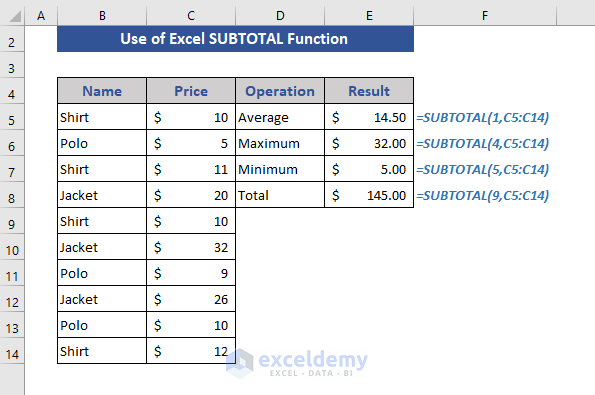5 Key Differences in Subtotal Functions: Google Sheets vs Excel

When dealing with spreadsheets, understanding the nuances of functions available in different platforms like Google Sheets and Microsoft Excel can significantly enhance your data management and analysis skills. Today, we'll delve into the key differences in how subtotal functions operate in Google Sheets and Excel. This comparison will not only clarify how these tools handle data but also help you decide which platform might be better suited for your specific needs.
Function Syntax and Usage

At first glance, both Google Sheets and Microsoft Excel offer the SUBTOTAL function, but they diverge in syntax and functionality:
- In Google Sheets, the SUBTOTAL function has the syntax
=SUBTOTAL(function_num, range)where:- function_num refers to the type of calculation to perform (1-11 for visible rows only; 101-111 for all rows including hidden).
- The range specifies the cell range over which the function is applied.
- In Microsoft Excel, the syntax is also
=SUBTOTAL(function_num, range1, [range2], ...)but:- The function_num works similarly, with 1-11 used for visible cells and 101-111 for all cells.
- Excel allows multiple ranges, giving it an edge in handling complex datasets.
📝 Note: The use of function numbers between 101-111 bypasses hidden rows in both platforms, making it essential for working with filtered or grouped data.
Filtering and Aggregation

While both applications can aggregate data, the way they handle filtered data differs:
- Google Sheets: The SUBTOTAL function automatically ignores rows hidden by filters, making it ideal for dynamic reporting where datasets frequently change.
- Excel: Excel's SUBTOTAL is slightly more versatile with the ability to aggregate data from multiple ranges, even if they are on different sheets, which is useful for large, multi-sheet datasets.
💡 Note: This flexibility in Excel comes at the cost of complexity; ensuring correct references in multi-range formulas can be challenging.
Error Handling

Both platforms differ in how they manage errors within the data they process:
- In Google Sheets, if an error is present in the specified range, it will propagate through the SUBTOTAL result, potentially skewing your data analysis.
- Excel provides a feature where the SUBTOTAL function skips errors and continues with the calculation, ensuring that an error does not derail your entire dataset aggregation.
Functionality with Nested Functions

Nesting functions within SUBTOTAL can lead to different results:
- Google Sheets: SUBTOTAL can be nested within itself to create hierarchies of calculations, but these nested SUBTOTALs must use function numbers 1-11 to avoid counting hidden data twice.
- Excel: Here, nested SUBTOTAL functions work seamlessly across visible and hidden rows, providing a richer functionality when creating complex, layered data analyses.
📋 Note: Careful management of function numbers is crucial when nesting SUBTOTAL functions to avoid unintended data aggregation in both applications.
Table of Subtotal Functions

| Function Number | Function in Google Sheets | Function in Excel |
|---|---|---|
| 1 or 101 | AVERAGE | AVERAGE |
| 2 or 102 | COUNT | COUNT |
| 3 or 103 | COUNTA | COUNTA |
| 4 or 104 | MAX | MAX |
| 5 or 105 | MIN | MIN |
| 6 or 106 | PRODUCT | PRODUCT |
| 7 or 107 | STDEV | STDEV.S |
| 8 or 108 | STDEVP | STDEV.P |
| 9 or 109 | SUM | SUM |
| 10 or 110 | VAR | VAR.S |
| 11 or 111 | VARP | VAR.P |

📚 Note: While the core functions are similar, note the slight variation in statistical functions between Google Sheets and Excel.
In wrapping up our exploration of the SUBTOTAL function differences between Google Sheets and Microsoft Excel, it's clear that each platform has tailored this function to suit specific user needs and data scenarios. Google Sheets excels in simplicity and dynamic adaptability for rapidly changing datasets, whereas Excel offers more advanced features for handling large, complex datasets with multiple sheets and detailed error management. Choosing the right tool depends heavily on your workflow, the complexity of your data, and your preference for either a straightforward or a feature-rich environment.
What happens if I use a SUBTOTAL function number outside of 1-11 in Google Sheets?

+
In Google Sheets, using a function number outside of 1-11 will calculate the values including any hidden rows. Numbers 101-111 do the same but are intended for operations on all cells, including those hidden by filters.
Can I use SUBTOTAL in Excel to summarize data from different sheets?

+
Yes, Excel allows you to include multiple ranges in the SUBTOTAL function, which can span across different sheets, making it a powerful tool for summarizing complex, multi-sheet data.
How does Excel handle errors in SUBTOTAL calculations?

+
Excel will skip over any errors within the specified range and continue calculating, ensuring that your aggregation remains accurate despite potential data issues.
Is there any visual difference when using SUBTOTAL in Google Sheets versus Excel?

+
The visual output is similar, but Excel provides more detailed options for customizing the display of subtotals, such as outlining and summary rows.
How can nested SUBTOTAL functions be useful?

+
Nested SUBTOTALs allow for hierarchical aggregation, enabling you to perform layered calculations within your dataset, which can be particularly useful for complex reports or data analysis tasks.



